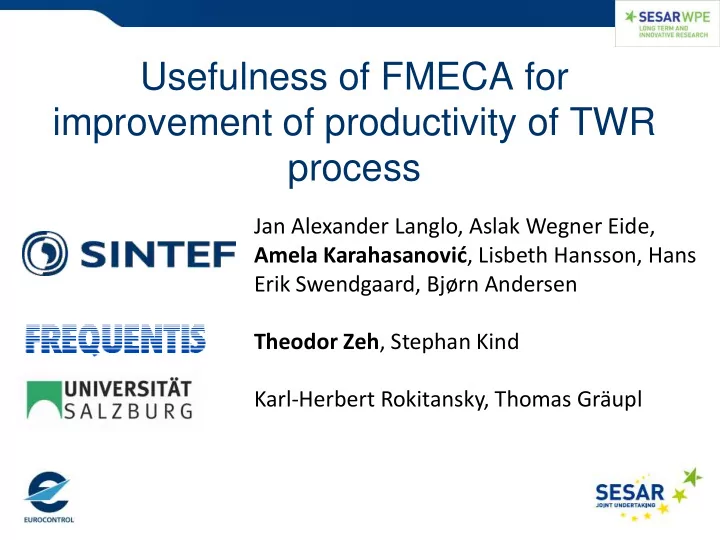

Usefulness of FMECA for improvement of productivity of TWR process Jan Alexander Langlo, Aslak Wegner Eide, Amela Karahasanović , Lisbeth Hansson, Hans Erik Swendgaard, Bjørn Andersen Theodor Zeh , Stephan Kind Karl-Herbert Rokitansky, Thomas Gräupl
The Hypothesis • Applying processes from mass production improves productivity and safety in ATM Systems. • Assumptions • An ATM Control Room is a sociotechnical system • An ATM Control Room is producing “something” • Main Questions • Can ATM be seen as production process? • Can the production be divided into value adding production steps? • Which process tools fit best?
ZeFMaP - Safety Critical Mass Production „ Production Process“ (Value Adding) Domain Know How: Workflow Analyses Business Blue Printing Improvement Usability Engineering: Optimized Man/Machine Symbioses HF Safety: Decision Points -> all possible decisions: xFMEA Analyses HF Productivity: x6sigma Optimisation Loop „KVP“ Production Step 1 Production Step 2 Production Step 3 Production Step n
FMECA & FTA • F ailure M ode and E ffects and C riticality A nalyses Simplified: (Product)FMECA shall detect and analyse failures of systems through analyses of possible malfunctioning of one ore more of its parts ( F ault T ree A nalyses). Every possible combination of malfunctioning parts are to be analysed. We looked for something like: • D ecision Q uality and S ystem-wide E ffect A nalyses would be the analogue method to gain system optimised decisions for every possible situation.
System-wide Decision Analyses Deterministic points for a decision HF Safety: Decision Points -> all possible decisions: xFMEA Analyses Decision Variables
Setup • Simulated Environment: Hamburg Airport (EDDH) • 5 Roles: Clearance Delivery, Ground, Apron 1, Apron 2, Tower • Two days; training and measured runs (37 flights in 37,5 minutes) • Defined Workflows & Separation Rules
Tools • 4D Aerospace: Radar & Auxiliary Display • Communication: Verbal • FREQUENTIS: Electronic Flight Strips • Clearances: CPDLC on flight strips
The goals of the first experiment Collecting the data for FMECA analysis • Is FMECA useful? • What is the quality of the Evaluating the decisions? experimental design, tools and measurements -> limited scenario
The data we collected • Log files, screen captures, observations, video, interviews, background and post-run questionnaires
Preparing the data • Synchronizing data sources • Coding handovers • Semi-automatic adaptations • Visual representations
FMECA analysis • System – effect of the five controllers' decisions (37,5 minutes, 27 departures, 10 arrivals) • Item – each of the role • Failure modes – list of possible non-optimal decisions for each position (expert walkthrough) CDR/APRON • Delay in strip take over • Delay in push back clearance • Rejected push back clearance (CTOC not valid) • ….
• Basic failure rate – number of decisions (with failure or success) per total number of decisions for each role • Severity – expert judgement for our KPIs (efficiency, flexibility, predictability, safety) • Crisis: 0 • Bad: 0.3 • Medium: 0.6 • Good :1
Results • No arrivals that can be improved • Non-optimum decisions for departures were related to 'Departure clearance to invalid CTOT' • Failure ratio - 0.23 • CDC criticality number – 0.23 (failure mode ratio 1) • Severity codes for predictability averaged to 0.49
Severity/predictability graph
Validity • Limited scenario – too easy for the controllers • More challenging scenario in the second experiment • Relatively small number of optimal decisions for closer investigation (225 optimal decisions; 19 non- optimal) • Collect all the decisions over a longer period and under different conditions • Grading and scales – expert judgement • Need validation
Conclusions and future work • Experiment 1 showed that the overall ZeFMaP process is probably useful. • Particularly the process analyses (step 1) worked well. • Simplifications through CPDLC could have affected the result. • FMECA could be useful on larger data sets and with more challenging scenarios (Experiment 2) but probably not in real-time settings • Next level of productivity improvement can be expected through real-time tools supporting system optimised decision • Follow up projects concentrating on this step could be useful.
Thank you for your attention! Questions? Suggestions? Contacts: Amela@sintef.no Theodor.Zeh@frequentis.com
Recommend
More recommend